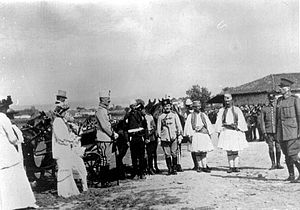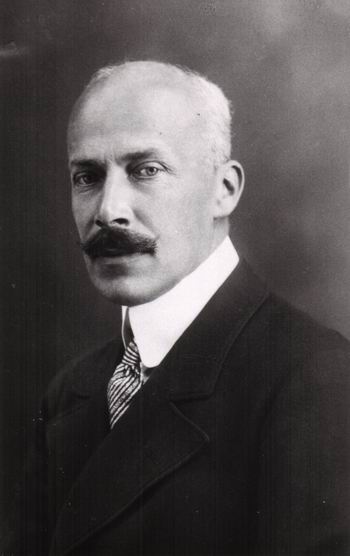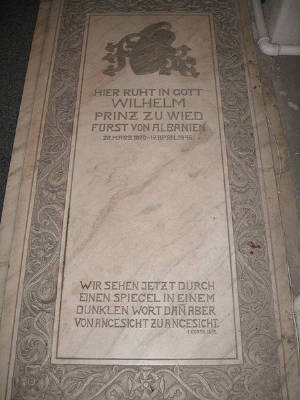Kingdom of Albania
Mbretnija Shqiptare
The Albanian Kingdom (Gheg Albanian: Mbretnija Shqiptare, Standard Albanian:
Mbretëria Shqiptare) was the constitutional
monarchal rule in Albania between
1928 and 1939. Albania was declared a monarchy by the Constituent Assembly,
and Zog I was crowned king.
The kingdom
was a restoration of the royal identity surviving from Scanderbeg's
reign in the 15th century. It also ensured the permanence of
democracy and order
in Albania, which had just regained independence from the Ottoman Empire
in 1912, The kingdom was supported by Italy
and the two countries maintained
close relations until Italy's sudden invasion of the country in 1939.
The Princely House of Wied
Prince William of Wied, Prince of Albania (Wilhelm Friedrich Heinrich)
(26
March
1876 - 18 April 1945) reigned briefly as sovereign of Albania from 7 March
1914 to 3 September 1914 when he left for exile. His reign
officially came to an end
on 31 January 1925 when the country was declared a republic. Outside the country
and in diplomatic correspondence, he
was styled "sovereign prince", but in Albania
he was referred to as mbret, or king. He was also styled Skanderbeg II, in
homage
to
Skanderbeg, the national hero. Born in Neuwied, he was the third son of
William (Wilhelm in German), 5th Prince of Wied (Prinz zu Wied
in German)
(brother
of Queen Elisabeth of Romania), and his wife Princess Marie
of the Netherlands (sister of Queen Louise of Sweden).
His paternal grandparents were Hermann, Prince of Wied, and Marie Wilhelmine
Friederike Elisabeth of Nassau-Weilburg.
Marie was a daughter of Wilhelm, Duke
of Nassau and his first wife Charlotte Louise of Saxe-Altenburg. Charlotte was a
daughter of Frederick, Duke of Saxe-Altenburg
and Duchess Charlotte Georgine
of Mecklenburg-Strelitz. His maternal grandparents were Prince Frederik of the
Netherlands and Princess Louise of
Prussia. Louise was a daughter of Frederick
William III of Prussia and Louise of Mecklenburg-Strelitz. Prince William served
as a Prussian cavalry officer before
becoming a captain in the German General
Staff in 1911.
Prince William's aunt Queen Elisabeth of Romania, on learning that the Great Powers
were looking for
a prince to rule over Albania, asked Take Ionescu to attempt to
persuade the great powers to appoint her nephew to the
post. Eventually the European
Great Powers, Austria-Hungary, the United Kingdom of Great Britain and Ireland, the
French Third Republic, the German Empire, the Russian Empire and the Kingdom of
Italy selected William, a member
of the German princely house of Wied, to rule over
newly-independent Albania. The announcement was made in November
1913 and the
decision was accepted by Ismail Qemali, the head of the provisional government.
The offer of the
Albanian throne was first made to him in the spring of 1913 but
he turned it down. Despite rejecting the offer, the
Austrians put pressure on
Prince William in an attemptto change his mind.

He let the Great Powers know on 7 February 1914 that he would accept the throne.
On 21 February 1914
a delegation of Albanian notables made a formal request,
which he accepted thereby becoming By the grace of the powers
and the will of
the people the Prince (Mbret) of Albania. One month after accepting the throne
on 7 March, he
arrived in his provisional capital of Durrës and started to
organise his government, appointing Turhan Pasha Përmeti
to form the first
Albanian cabinet. This firt cabinet was dominated by members of nobility
(prince Essad pacha
Toptani defence and foreign affairs, prince George
Adamidi bey Frachery finances, prince Aziz pacha Vrioni agriculture).

His brief reign proved a turbulent one. Immediately following his arrival revolts
broke out in central Albania against his Chief Minister, Essad Pasha, and against
foreign domination. Greece encouraged the formation of "provisional government of
North Epirus".
Although an agreement was made to grant extra rights to the Greek
minority, the Hellenic Army
occupied Southern Albania excluding Berat and Korçë.
William's position was also undermined
by own officials, notably Essad Pasha
himself, who accepted money from Italy to finance a revolt
and to stage a coup
against William. Pasha was arrested on 19 May 1914 and tried for treason and
sentenced to death. Only the intervention of Italy saved his life and he escaped
to Italy in exile. The outbreak of World War I presented more problems for Prince
William
as Austria-Hungary demanded that he send Albanian soldiers to fight
alongside them. When he refused,
citing the neutrality of Albania in the
Treaty of London, the remuneration that he had been receiving
was cut off.

With Albania in a state of civil war since July 1914, Greece occupying the
south
of
the country, the great powers at war with one another, his regime collapsed,
and so Prince William left the country on 3 September 1914 originally
heading to
Venice. Despite leaving Albania he did so insisting that he remained head of state.
Although several of the factions competing
for power in postwar Albania billed
themselves as regencies for William, once central authority was definitively
restored in 1924 the country was declared
a republic on 31 January 1925, officially
ending his reign. With the monarchy in Albania set to be restored with President
Ahmet Zogu becoming king, Prince William
reaffirmed his claim to the throne
announcing he still claimed the throne for himself and his heirs. Prince William died
in Predeal, near Sinaia, in Romania leaving
his son Hereditary Prince Carol Victor
as heir to his Albanian claims. He was buried in the Lutheran church in Bucharest.
The Family Titles and Styles of the House of Wied
The
members of this family bore the titles of Prince or Princess of Albania and
Prince or Princess zu Wied together with the formal appellation
of His or Her
Highness. The title and style used for the Prince in Albanian was Mbret (King
or Emperor) and Madheri (Majesty) as used by the Ottoman Empire.
The Genealogy of the Princely House of Wied
H.H. Prince William of Wied, Prince of Albania (German: Wilhelm Friedrich
Heinrich; Albanian:
Princ Vidi) (26 March 1876 - 18 April 1945) reigned briefly
as sovereign of Principality of Albania as Vidi I from 7 March 1914 to 3 September
1914 when he left for exile. His reign officially
came to an end on 31 January
1925
when the country was declared a Albanian Republic. Outside the country and
in diplomatic correspondence, he was styled "sovereign prince",
but in Albania he
was
referred to as mbret, or king. He was also styled Skanderbeg II, in homage
to Skanderbeg, the national hero
1) H.H. Prince Carol Victor, Hereditary Prince of Albania (19 May 1913 - 8 December
1973) was the only son of William, Prince of Albania
and briefly heir to the Principality
of Albania. He held the title of Hereditary Prince of Albania. Carol Victor was
born on 19 May 1913 in Potsdam, Kingdom of Prussia as Prince Charles
Victor of
Wied (German:
Karl Viktor Prinz zu Wied). He was the second child and only son
of Prince William Frederick of Wied (1876-1945), son of William, Prince of Wied
and Princess Marie of the Netherlands, and his
wife, Princess Sophie of Schönburg
-Waldenburg (1885-1936), daughter of Victor, Hereditary Prince of Schönburg
-Waldenburg and his wife Princess Lucia of Sayn-Wittgenstein-Berleburg.
Through her maternal
grandmother was related with the Dutch Royal Family.
His great-grandparents were King William I of the Netherlands and King
Frederick William III of Prussia.
1) H.H. Princess Maria Eleanora, Princess of Albania (Prinkësh i Shquipëria).
b. at Potsdam, Prussia, 19o9 February 1909, She
d.s.p. in a Communist
internment
camp at Miercurea Ciuc, Rumania, 29th September 1956.
The Royal Albanian House of Zogu
The House of Zogu is a European dynasty founded by Zogu Pasha who migrated
to Mati, Albania in the late 15th century
and was then appointed Governor of Mati
by the Ottoman Sultan, with the position of Governor then becoming hereditary
among the Zogu clan. The ancestral home
of the Zogus was Castle Burgajet. The most
famous member of the dynasty is Zog I, Skanderbeg III, who in 1928 was proclaimed
King of the Albanians and ruled until he
was deposed by Victor Emmanuel III of
Italy and the Italian invasion in 1939. Victor Emmanuel subsequently assumed the
Albanian throne. The current head of the
dynasty is King Zog's son
Leka, Crown Prince of Albania, known as King Leka.
Albanian Royal Family Titles and Styles
The Albanian
Sovereign bears the Titles of Mbret i Shqiptarëvet, King of the
Sons of the Eagle King of the Albanians with the formal appellation
of His
Majesty. The Heir Apparent bears the Titles of Princ i Shqiptarëve, Trashëgimtar,
Crown Prince of Albania with the formal
appellation of His Royal Highness.
The Sons of the Albanian Sovereign and male descendants in the male line
bear the Titles of Princ i Shqiptarë,
Prince of Albania with the formal appellation
of His Royal Highness. The Daughters of the Albanian Sovereign, and female
descendants in the male line, bear the Titles
of Princësh i Shqiptarë, Princess
of Albania with the formal appellation of Her Royal Highness.
The Genealogy of the Royal House of Albania
Amet Bej Zogu became ruler of Albania after the First World War, and
on 1
September
1928 was proclaimed "King of the Albanians". He ruled until the
Italian invasion in April 1939. When he became king he
granted royal rank to
his mother and siblings. The siblings were accorded the style "Highness". The
issue of the king were accorded the
style "Royal Highness". The titles of the
issue of Zog's siblings is unclear, but they seem to be "Prince (or Princess) Zogu"
Xhemal Zogu Pasha, Hereditary Governor
of Mati, b.Burgajet ca 1860, d.Mati 1911
(1904?). He m.1st at Mati in 1880 Melek Zogu (Burgajet 18__-Burgajet 1884);
m.2d at Mati 1891 Sadijé Toptani, who was accorded the title
"Queen
Mother of
the Albanians" in 1928 (28 Aug 1876-Tirana 25 Nov 1934)
1a) Pr Xhelal Bey Zogu (Burgajet 14 May 1881-Istanbul
26 Feb 1944); m.1st
Burgajet
1908 (div 1912) Ruhijé Doshishti (Dibra 9 Mar 1881-Cannes 6 Dec 1956);
m.2d Burel 1931 Ikbal Pekkini (b.at Pekkini, d.Burel 3 May 1932);
m.3d Burel
2 Aug 1932
(div 1933) Faika Minxhalliu (Delvine 1897-Kruja 9 Dec 1935); m.
4th Burel May 1933 Hyrijet Allaj (Elbasan 1916-Alexandria 17 Oct 1993)
1b) Said (b.and d.Burgajet 1909)
2b) Malika (b.and d.Burgajet 1911)
3b) [Pss] Elvira, b.Burel 3
May 1932; m.Alexandria, Egypt 10 Jun 1955
(sep 1986) Ibrahim Hadidi (b.Alexandria 9 Oct 1934)
4b) [Pr] Skender, b.Davos 3 Jun 1933; m.Compiègne
10 Nov 1962 Jacqueline
Cosme (Bucquy, Pas de Calais 7 Aug 1932-Senlis 14 Dec 2001)
1c) [Pss] Virginie Alexandra Geraldine, b.Compiègne
25 Jan 1963; m.St.Jean-
de-Luz
6 Jun 1987 Raphael de Urresti (b.St.Jean-de-Luz 18 Oct 1959)
5b) [Pss] Melita, b.Burel 18 Jun 1934; m.Alexandria
22 Feb
1958 Abdel Aziz
Khadr (Alexandria 20 Oct 1927-2002)
6b) [Pss] Vera, b.Durazzo 3 Feb 1936; m.1st Cairo 24 Dec 1955 (div 1961) Essawi
Khadr (b.Mahallah, Egypt 12 Jan 1936); m.2d Cairo
1970 Nasser El Gueneyni
7b) [Pr] Mirgin, b.Durazzo 3 Sep 1937; m.Cannes 23 Nov 1959
Maryse Alexandrine Juliette Ferrando (b.Cannes
17 Jan 1934)
1c) [Pr] Alexandre, b.Paris 10 Jan
1963; m.Emmanuelle Munoz
1d) Erina (b.1994)
2d) Anna (b.1995)
3d) Flora (b.1996)
2c) [Pr] Michel, b.Cannes 16 Sep 1966
8b) [Pr] Genc (Tirana 3 Nov
1938-Istanbul 17 Apr 1944)
2a) Pss Adilé (Mati
25 Feb 1894-Paris 1966);
m.Emin
Agolli Doshishti (1890-1938)
3a) H.M. Zog I, King of the Albanians, Skanderbeg III of the Albanians (Albanian:
Nalt Madhnija e Tij
Zogu I, Mbreti i Shqiptarëvet, IPA: [ˈzɔɡu]; 8 October 1895 - 9 April
1961), born Ahmet Muhtar Bej Zogolli, was King of Albania from 1928
to 1939. He was
previously
Prime Minister of Albania (1922-1924) and President of Albania (1925-1928).
1b) H.M. Leka I, King of the Albanians Leka, b. 5 April 1939 - 30 November
2011),
was the only
son of King Zog I of the Albanians and his queen, born Countess
Géraldine Apponyi de Nagyappony. He was called Crown Prince Skander at birth.
Leka was pretender to the Albanian throne and
was referred to as King Leka I
by Albanian monarchists.
1c) HRH Crown Prince Leka of the Albanians (Leka Anwar Zog Reza Baudouin
Msiziwe Zogu, born 26 March 1982) is the only
child of the late King Leka I of
Albania, and the late Susan Cullen-Ward. Prince Leka is an official at the Albanian
Ministry of Interior and in the past has served
at the Albanian Ministry of Foreign
Affairs. The prince is referred by some Albanian monarchists as King Leka II,
since the death of his father, who was known as Leka I as King of
the Albanians.
In May
2010, the Prince was engaged to Elia Zaharia, an Albanian actress and singer.
On 30 November 2011, he succeeded as head of the House of Zogu, titular
King of
the Albanians,
and 3rd Sovereign Head of the Order of Besa and
of the Order of Skanderbeg, upon the death of his father.
4a)
Pss Nafijé (Mati 12 Sep 1900-Egypt 21 Mar 1955); m.1922
Ceno
Bey Kriziu (Kosova
1887-assasinated at Prague 14
Oct 1927)
5a) Pss Senijé (Mati 15 Nov 1908-Cannes 15 Apr 1969); m.Tirana 12 Jan 1936
(div 1949) Pr Mehmen Abid of Turkey (Yildiz 17
Sep 1905-Paris 8 Dec 1973)
6a) Pss Myzejen (Mati 10 Nov 1909-Cannes 10 Apr 1969)
7a) Pss Ruhijé
(Mati 23 Dec 1910-Cairo 31 Jan 1948)
8a) Pss Maxhidé (Mati 8 Oct 1911-Cannes 12 Oct 1969)
Line of Succession to the Albanian Throne
The Albanian
monarchy was overthrown in 1939 when King Zog fled the country
following an invasion by Mussolini's Italy. The pretender and head of the
House
of
Zogu since the deaths of both King Zog in 1961 and Zog's son King Leka I, in 2011,
is HRH Prince
Leka II of Albania (b. 1982), following this the line of succession
is unclear, however, if Prince Leka II dies
without issue it is expected he shall
appoint a cousin of his father's to become head of the House of Zogu and,
therefore, claimant to the Throne.

